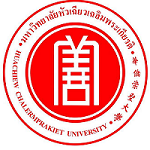Please use this identifier to cite or link to this item:
https://has.hcu.ac.th/jspui/handle/123456789/3925| Title: | ปากน้ำเมืองท่าโบราณ: ความเชื่อและวิถีชีวิตของชาวจีน |
| Other Titles: | Pak Nam the Old Port: Traditional Beliefs and the Way of Life |
| Authors: | พรพรรณ จันทโรนานนท์ ไพศาล ทองสัมฤทธิ์ Pornpan Juntaronanon Phaisan Thongsamrit 刘丽芳 陈慕贤 Huachiew Chalermprakiet University. College of Chinese Studies Huachiew Chalermprakiet University. College of Chinese Studies |
| Keywords: | ชาวจีน -- ไทย Chinese -- Thailand 中国人 -- 泰国 ความเชื่อ Belief and doubt 信仰 จีน -- ความเป็นอยู่และประเพณี China -- Social life and customs 中国 -- 社会生活与习俗 สมุทรปราการ -- ความเป็นอยู่และประเพณี Samut Prakarn -- Social life and customs อัตลักษณ์ทางวัฒนธรรม ปากน้ำ (สมุทรปราการ) Pak Nam (Thailand, Samut Prakarn) 北榄(北榄府) 文化认同 北榄府 -- 生活方式和传统 |
| Issue Date: | 2016 |
| Abstract: | ปากน้ำเมืองท่าโบราณ มีบทบาทด้านการค้ามาตั้งแต่สมัยอยุธยาและเป็นเมืองที่เรือใหญ่ต้องจอดแวะพักเพื่อถ่ายสินค้าลงเรือเล็กเข้าสู่แม่น้ำเจ้าพระยา ปากน้ำจึงกลายเป็นที่อยู่อาศัยชั่วคราวของชาวจีนอพยพที่รอญาติมารับและเป็นที่อยู่ถาวรของพวกเสี่ยงภัยที่เดินทางมาหาอนาคตข้างหน้า ชาวจีนแต้จิ๋วอพยพเข้าสู่ประเทศไทยมากที่สุดและที่ปากน้ำก็เช่นกัน มีชาวจีนแต้จิ๋วตั้งหลักแหล่งมากที่สุด รองลงมา คือ ชาวฮากกา และไหหลำ ชาวจีนแต้จิ๋วรุ่นแรกๆ อยู่ที่นี่มากว่า 7-8 ชั่วอายุคนแล้ว การตั้งถิ่นฐานของชาวจีนอพยพที่ปากน้ำก็เหมือนกับที่อื่นๆ ในโลก กล่าวคือจะอาศัยอยู่กันเป็นกลุ่มตามบ้านเกิด ความสัมพันธ์ทางสายโลหิตและกลุ่มที่มีอาชีพแบบเดียวกัน (地缘)、血缘、业缘)และมีวิถีชีวิตตามแบบบ้านเกิด ด้วยเหตุนี้จึงทำให้แหล่งที่อยู่อาศัยของพวกเขากลายเป็นเมืองจีนขนาดเล็ก(唐人街)โดยเริ่มต้นจากศาลเจ้าพ่อหลักเมืองสมุทรปราการ((北榄府城隍庙)หรือที่ชาวจีนในพื้นที่เรียกกันว่า "ศาลเจ้าเซี่ยอึ่งกง" (แต้จิ๋ว) แล้วเลียบถนนประโคนชัย ข้ามสะพาน ไปถึงวงเวียนแล้วเลี้ยวขวาเข้าถนนท้ายบ้าน บริเวณเมืองจีนขนาดเล็กนี้ ได้แบ่งแหล่งชุมชนชาวจีนออกเป็น 3 แห่ง แห่งที่ 1 คือชุมชนย่านศาลเจ้าพ่อหลักเมืองสมุทรปราการ แห่งที่ 2 คือย่านโรงเจถ่งเสียง(同善坛) ศาลเจ้าเล่าปุงเถ่ากง(老本头公庙)และศาลเจ้าลีเอี่ยกง (玄天上帝庙)ซึ่งเป็นเขตโรงเรียนป้วยฮั้วเก่า และแห่งที่ 3 คือ ย่านมูลนิธิสุสานปาน้ำไต้ฮง(大峯祖庙)ซึ่งอยู่ที่ถนนท้ายบ้านระหว่างซอย 13-15 และที่ถนนท้ายบ้านมีศาลเจ้าแม่ทับทิม
ในการวิจัยนี้ ผู้วิจัยได้ข้อมูลจากผู้ให้ข้อมูลสำคัญ ที่ตำบลปากน้ำ อำเภอเมืองสมุทรปราการ 24 ราย ที่ตำบลนาเกลือ อำเภอพระสมุทรเจดีย์ 6 ราย ที่ตำบลปากน้ำนั้นยังเหลืออัตลักษณ์ของประเพณีจีน ไว้อย่างเข้มข้น ทั้งระดับมหภาคและจุลภาค ทั้งนี้ เพราะชาวจีนยังเกาะกลุ่มกันแน่นตรงกันข้ามกับที่ตำบลนาเกลือ หมู่บ้านสาขลา ตลาดโบราณ เนื่องจากการตั้งถิ่นฐานของชาวจีนอพยพที่นี่มีชาวพื้นถิ่นมาก อีกทั้งไม่มีองค์การของชาวจีนอันเป็นปัจจัยบวกที่จะส่งเสริมให้พวกเขาสามารถรักษาอัตลักษณ์ของบรรพบุรุษได้ จึงส่งผลให้บุตรหลานของพวกเขากลายเป็นไทยอย่างสมบูรณ์ในช่วงเวลาชั่วคนที่สองเท่านั้น Pak Nam, ancient seaport, has had commercial roles since Ayutthaya era and it is the city that large vessels shall port or stop over to discharge goods onto small vessels into Chaophaya River. Pak Nam became the temporary residence of Chinese persons who waiting for relatives to pick them up and became the permanent residence of risk persons coming to find future. Teochew people (潮州人) immigrated to Thailand at Pak Nam the most and Hakka people (客家人) were the secondary. Teochew lived here for more than 7-8 generations. Settlement of Chinese immigrants in Pak Nam was like other places in the world, live in group according to homeland, blood and occupation (地缘)、血缘、业缘)and they had way of living in their homeland style. Therefore their living source became small China town (唐人街). Pak Nam China town starting from Samut Prakan City God Shrine (北榄府城隍庙), or Chinese people in the area called Shia Ung Kong Shrine, along Prakhonchai Road (ถนนประโคนชัย), crossing a bridge, going along the road reaching the circle and turning right to Tai Ban Road (ถนนท้ายบ้าน), in this small Prakan City God Shrine; the second source was Tong Xiang Vegetarian Building (同善坛), Lao Pung Thao Gong Shrine (老本头公庙) and Li Ye Gong Shrine (玄天上帝庙) which was the area of the old Puay Hua School and the third Chinese community, the area, of Tai Hong Shrine (大峯祖庙) area, on Tai Ban Road between Alley 13-15 and Tai Ban Road corner, there was Thab Thim Goddess Shrine. In this research, I had interviewed 30 key Informants, 24 are in Pak Nam Sub-district and 6 from Na Klua Sub-district. Pak Nam Sub-district left identities of Chinese customs and culture intensely in macro and micro levels, as Chinese people grouped together tightly. In the opposite manner, in Na Klua Sub-district, Sakhla Village, ancient market, because Chinese immigrants settle here, there were a lot of local people. There is no organization of Chinese people that is positive factor, affecting their children to acquire Thai nationality to be Thai person completely during the period of the second generation only. |
| Description: | การประชุมวิชาการระดับชาติด้านจีนศึกษา ครั้งที่ 1 ประจำปี 2559 “จีนศึกษา ภาษาจีน: บทบาทต่อประชาคมโลก”, 7 ตุลาคม 2559 ห้อง 306 อาคารศรีจุฬาลักษณ์ มหาวิทยาลัยรามคำแหง : หน้า 44-57. 2016年首届中国学学术研讨会论文集 : 44-57. Proceedings of the 1st National Conference on Chinese Studies 2016 : 44-57. |
| URI: | https://has.hcu.ac.th/jspui/handle/123456789/3925 |
| Appears in Collections: | College Of Chinese Studies - Proceeding Document |
Files in This Item:
| File | Description | Size | Format | |
|---|---|---|---|---|
| Pak-Nam-the-Old-Port-Traditional-Beliefs-and-the-Way-of-Life.pdf | 4.51 MB | Adobe PDF | View/Open |
Items in DSpace are protected by copyright, with all rights reserved, unless otherwise indicated.
